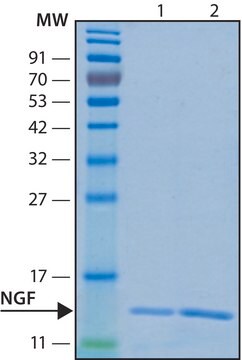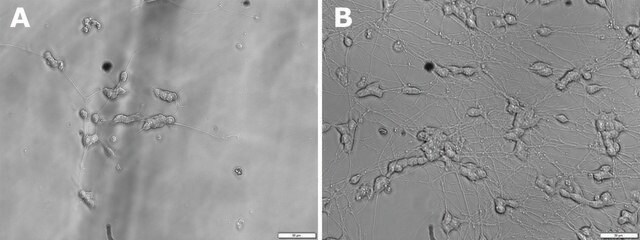SRP3015
Beta NGF human
recombinant, expressed in E. coli, ≥98% (SDS-PAGE), ≥98% (HPLC), suitable for cell culture
Synonym(s):
beta-Nerve Growth Factor
Sign Into View Organizational & Contract Pricing
All Photos(1)
About This Item
UNSPSC Code:
12352202
NACRES:
NA.32
Recommended Products
biological source
human
recombinant
expressed in E. coli
Assay
≥98% (HPLC)
≥98% (SDS-PAGE)
form
lyophilized
potency
<1.0 ng/mL ED50
mol wt
13.5 kDa
packaging
pkg of 20 μg
technique(s)
cell culture | mammalian: suitable
impurities
<0.1 EU/μg endotoxin, tested
UniProt accession no.
shipped in
wet ice
storage temp.
−20°C
Gene Information
human ... NGF(4803)
General description
β-NGF is a neurotrophic factor structurally related to BDNF, NT-3 and NT-4. These proteins belong to the cysteine-knot family of growth factors that assume stable dimeric structures. β-NGF is a potent neurotrophic factor that signals through its receptor β-NGFR, and plays a crucial role in the development and preservation of the sensory and sympathetic nervous systems. β-NGF also acts as a growth and differentiation factor for B lymphocytes and enhances B-cell survival. The functional form of human β-NGF is a noncovalently disulfide-linked homodimer, of two 13.5 kDa polypeptide monomers (240 total amino acid residues). The three disulfide bonds are required for biological activity.
Application
β NGF human has been used in immunohistochemistry.
Biochem/physiol Actions
β-NGF is a neurotrophic factor structurally related to BDNF, NT-3 and NT-4. The functional form of human b-NGF is a noncovalently disulfide-linked homodimer, of two 13.5 kDa polypeptide monomers (240 total amino acid residues). The three disulfide bonds are required for biological activity.
Sequence
SSSHPIFHRG EFSVCDSVSV WVGDKTTATD IKGKEVMVLG EVNINNSVFK QYFFETKCRD PNPVDSGCRG IDSKHWNSYC TTTHTFVKAL TMDGKQAAWR FIRIDTACVC VLSRKAVRRA
Physical form
Lyophilized with no additives.
Reconstitution
Centrifuge the vial prior to opening. Reconstitute in water to a concentration of 0.1-1.0 mg/ml. Do not vortex. This solution can be stored at 2-8°C for up to 1 week. For extended storage, it is recommended to further dilute in a buffer containing a carrier protein (example 0.1% BSA) and store in working aliquots at -20°C to -80°C.
Storage Class Code
11 - Combustible Solids
WGK
WGK 3
Flash Point(F)
Not applicable
Flash Point(C)
Not applicable
Choose from one of the most recent versions:
Certificates of Analysis (COA)
Lot/Batch Number
Sorry, we don't have COAs for this product available online at this time.
If you need assistance, please contact Customer Support.
Already Own This Product?
Find documentation for the products that you have recently purchased in the Document Library.
Customers Also Viewed
H Zhang et al.
European journal of histochemistry : EJH, 59(3), 2522-2522 (2015-10-03)
The nerve growth factor (NGF) not only has an essential effect on the nervous system, but also plays an important role in a variety of non-neuronal systems, such as the reproductive system. The aim of this study was to investigate
The nerve growth factor 35 years later.
R Levi-Montalcini
Science (New York, N.Y.), 237(4819), 1154-1162 (1987-09-04)
A Ullrich et al.
Nature, 303(5920), 821-825 (1983-06-30)
Nerve growth factor (NGF) is thought to have a profound effect on the development and maintenance of sympathetic and embryonic sensory neurones (see refs 1-3 for review). NGF activity isolated from the male mouse submaxillary gland (MSG) consists of three
Li Xiao et al.
Neural regeneration research, 15(12), 2270-2272 (2020-07-01)
As an aging-associated degenerative disease, Alzheimer's disease is characterized by the deposition of amyloid beta (Aβ), oxidative stress, inflammation, dysfunction and loss of cholinergic neurons. Colla Corii Asini (CCA) is a traditional Chinese medicine which has been used for feebleness-related
Benita Wiatrak et al.
Cells, 9(4) (2020-04-17)
The PC12 cell line is one of the most commonly used in neuroscience research, including studies on neurotoxicity, neuroprotection, neurosecretion, neuroinflammation, and synaptogenesis. Two types of this line are available in the ATCC collection: traditional PC12 cells grown in suspension
Our team of scientists has experience in all areas of research including Life Science, Material Science, Chemical Synthesis, Chromatography, Analytical and many others.
Contact Technical Service









